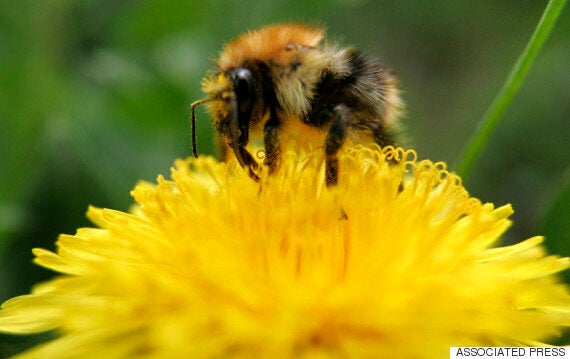Bumblebees are at risk of future extinction because of climate change, according to a study of 67 species. Scientists found that global warming was shrinking the geographic range of many species in Europe and North America, with the geographic squeeze occurring over the past 40 years. The study noted that while the northern borders of each species' territory remained about the same on average, the southern borders generally moved northward.

A bumblebee crawls on the blossom of a dandelion in Minsk, Belarus, Wednesday, May 6, 2009
That shift, by more than 100 miles in some cases, was most pronounced for species in the southern parts of the study areas. In North America, the study extended from the southern United States to northern Alaska. The range loss implies that populations have declined and are on the road to disappearing, said study leader Jeremy Kerr, of the University of Ottawa in Canada. Results were released Thursday by the journal Science.
Analysis showed the changes were not due to differences in land use or the use of pesticides. "The only explanation we've got is that it's too hot for them," Kerr said. Bumblebees are furry-looking and wild cousins of honeybees. They play a crucial role in nature by pollinating wild plants and also some crops such as tomatoes and blueberries.
Kerr said that because the geographic ranges of species overlap, the new study does not mean that vast areas of the continents have lost bumblebees completely. Rather, it means that many areas host fewer species than they used to. Such loss of diversity can hamper an environment's ability to cope with changes like droughts, he said in an interview.
The bee trend was surprising because other land creatures like butterflies have extended their range north while maintaining their southern boundaries, researchers said. Kerr's study drew on museum records of bumblebees captured by naturalists and researchers over decades. It focused on about 423,000 cases where the species, location and year of capture were known. Researchers set a baseline distribution of the species found between 1901 and 1974, and looked for changes at later time periods, most recently 1999 to 2010.
May Berenbaum, who heads the entomology department of the University of Illinois at Urbana-Champaign, praised the scope of the study and said it shows bumblebees will not simply shift northward to cope with rising temperatures. "It's not that simple," said Berenbaum, who didn't participate in the study. "They may be running out of options."
SEE ALSO:
- When Will America Elect An Openly Gay President?
- Christians Should Resist Gay Marriage With 'Civil Disobedience'
- 'Stop Combatting Climate Change And Promote Traditional Marriage'
- CNN Mistakenly Spots ISIS Flag At London Pride
- South Carolina Confederate Flag Removed By Daring Female Activist
- Gay Marriage Decision Called 'The New 9/11'